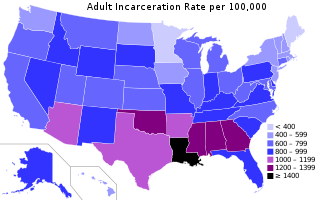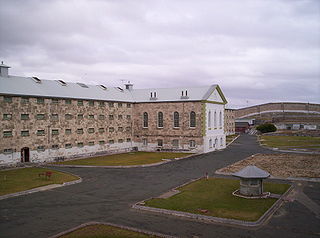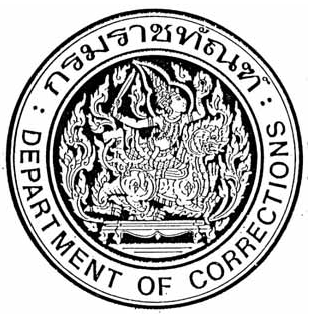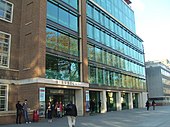Related Research Articles

Incarceration in the United States is a primary form of punishment and rehabilitation for the commission of felony and other offenses. The United States has the largest prison population in the world, and the highest per-capita incarceration rate. One out of every 5 people imprisoned across the world is incarcerated in the United States. In 2018 in the US, there were 698 people incarcerated per 100,000; this includes the incarceration rate for adults or people tried as adults. Prison, parole, and probation operations generate an $81 billion annual cost to U.S. taxpayers, with an additional $63 billion for policing. Court costs, bail bond fees, and prison phone fees generate another $38 billion in individual costs.

Recidivism is the act of a person repeating an undesirable behavior after they have experienced negative consequences of that behavior. It is also used to refer to the percentage of former prisoners who are rearrested for a similar offense.

Incapacitation in the context of criminal sentencing philosophy is one of the functions of punishment. It involves capital punishment, sending an offender to prison, or possibly restricting their freedom in the community, to protect society and prevent that person from committing further crimes. Incarceration, as the primary mechanism for incapacitation, is also used as to try to deter future offending.

In September 2013, the incarceration rate of the United States of America was the highest in the world at 716 per 100,000 of the national population; by 2019 it had fallen to 419 in state and federal prisons per 100,000. Between 2019 and 2020, the United States saw a significant drop in the total number of incarcerations. State and federal prison and local jail incarcerations dropped by 14% from 2.1 million in 2019 to 1.8 million in mid-2020. While the United States represents about 4.2 percent of the world's population, it houses around 20 percent of the world's prisoners. Corrections cost around $74 billion in 2007 according to the U.S. Bureau of Justice Statistics (BJS). According to the Justice Expenditures and Employment in the United States, 2017 report release by BJS, it's estimated that county and municipal governments spent roughly US$30 billion on corrections in 2017.

A prison, also known as a jail or gaol, penitentiary, detention center, correction center, correctional facility, lock-up, hoosegow or remand center, is a facility in which inmates are confined against their will and usually denied a variety of freedoms under the authority of the state as punishment for various crimes. Prisons are most commonly used within a criminal justice system: people charged with crimes may be imprisoned until their trial; those pleading or being found guilty of crimes at trial may be sentenced to a specified period of imprisonment. In simplest terms, a prison can also be described as a building in which people are legally held as a punishment for a crime they have committed.
Indigenous Australians are both convicted of crimes and imprisoned at a disproportionately higher rate in Australia, as well as being over-represented as victims of crime. As of September 2019, Aboriginal and Torres Strait Islander prisoners represented 28% of the total adult prisoner population, while accounting for 2% of the general adult population. Various explanations have been given for this over-representation, both historical and more recent. Federal and state governments and Indigenous groups have responded with various analyses, programs and measures.

Punishment in Australia arises when an individual has been accused or convicted of breaking the law through the Australian criminal justice system. Australia uses prisons, as well as community corrections, When awaiting trial, prisoners may be kept in specialised remand centres or within other prisons.

This article discusses the incarceration of women in correctional facilities. As of 2013 across the world, 625,000 women and children were being held in penal institutions, and the female prison population was increasing in all continents. The list of countries by incarceration rate includes a main table with a column for the historical and current percent of prisoners who are female.

The Federal Penitentiary Service is a federal agency of the Ministry of Justice of Russia responsible for correctional services.

The alternatives to imprisonment are types of punishment or treatment other than time in prison that can be given to a person who is convicted of committing a crime. Some of these are also known as alternative sanctions. Alternatives can take the form of fines, restorative justice, transformative justice or no punishment at all. Capital punishment, corporal punishment and electronic monitoring are also alternatives to imprisonment, but are not promoted by modern prison reform movements for decarceration due to them being carceral in nature.
Prison overcrowding is a social phenomenon occurring when the demand for space in prisons in a jurisdiction exceeds the capacity for prisoners. The issues associated with prison overcrowding are not new, and have been brewing for many years. During the United States' War on Drugs, the states were left responsible for solving the prison overcrowding issue with a limited amount of money. Moreover, federal prison populations may increase if states adhere to federal policies, such as mandatory minimum sentences. On the other hand, the Justice Department provides billions of dollars a year for state and local law enforcement to ensure they follow the policies set forth by the federal government concerning U.S. prisons. Prison overcrowding has affected some states more than others, but overall, the risks of overcrowding are substantial and there are solutions to this problem.

The incarceration of women in the United States refers to the imprisonment of women in both prisons and jails in the United States. There are approximately 219,000 incarcerated women in the US according to a November 2018 report by the Prison Policy Initiative, and the rate of incarceration of women in the United States is at a historic and global high, with 133 women in correctional facilities per every 100,000 female citizens. The United States is home to just 4% of the world's female population, yet the US is responsible for 33% of the entire world's incarcerated female population. The steep rise in the population of incarcerated women in the US is linked to the complex history of the War on drugs and the US's Prison–industrial complex, which lead to mass incarceration among many demographics, but had particularly dramatic impacts on women and especially women of color. However, women made up only 10.4% of the US prison and jail population, as of 2015.

The United States has the highest prison and jail population, and the highest incarceration rate in the world. According to the World Prison Population List there were around 10.35 million people in penal institutions worldwide in 2015. The US had 2,173,800 prisoners in adult facilities in 2015. That means the US held 21.0% of the world's prisoners in 2015, even though the US represented only around 4.4 percent of the world's population in 2015.

The Department of Corrections is an agency of the Thai Ministry of Justice. Its mission is to keep prisoners in custody and rehabilitate them. Its headquarters is in Suanyai Sub-district, Mueang Nonthaburi District, Nonthaburi Province. As of 2020, Police Colonel Suchart Wongananchai is director-general of the department. Its FY2019 budget was 13,430 million baht.
People in prison are more likely than the general United States population to have received a mental disorder diagnosis, and women in prison have higher rates of mental illness and mental health treatment than do men in prison. Furthermore, women in prisons are three times more likely than the general population to report poor physical and mental health. Women are the fastest growing demographic of the United States prison population. As of 2019, there are about 222,500 women incarcerated in state and federal prisons in the United States. Women comprise roughly 8% of all inmates in the United States.
Criminal justice reform addresses structural issues in criminal justice systems such as racial profiling, police brutality, overcriminalization, mass incarceration, and recidivism. Criminal justice reform can take place at any point where the criminal justice system intervenes in citizens’ lives, including lawmaking, policing, and sentencing.
Norway's criminal justice system focuses on the principles of restorative justice and the rehabilitation of prisoners. Correctional facilities in Norway focus on maintaining custody of the offender and attempting to make them a functioning member of society. Norway's laws forbid the use of torture and other cruel, inhuman, or degrading treatment as punishment. Prison conditions typically meet international standards, and the government permits visits by any human rights observers. The system is considered to be transparent, and prisoners are represented by an ombudsman, an official appointed to investigate individuals’ complaints against public authority.


